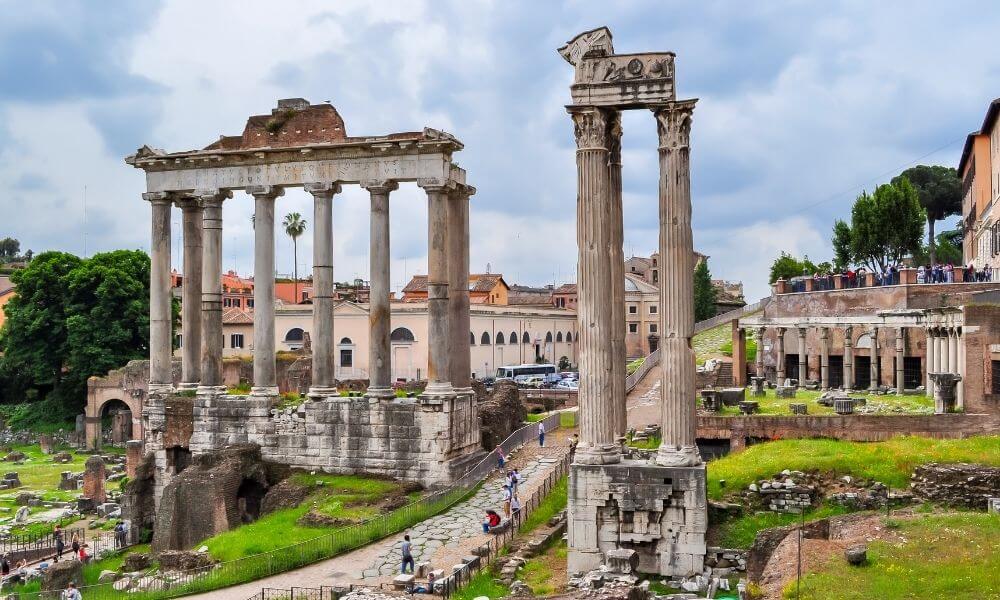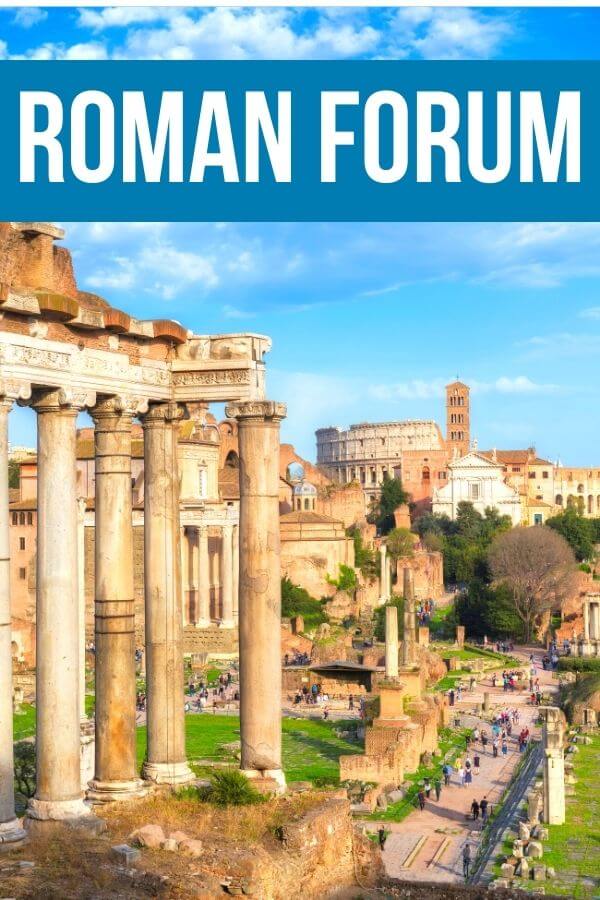Last Updated on December 23, 2021 by Soumya
Visiting the Roman Forum? Planning to add this stunning Italian landmark to your Rome itinerary? Keen to find out all about Roman Forum tickets, opening hours, and guided tours?
Well, you are in luck. Because we have just the perfect Roman Forum travel guide for you.
Rome’s historic center, a UNESCO World Heritage Site, is home to 3 iconic monuments – the Colosseum, the Palatine Hill, and the Roman Forum. Colosseum refers to the ancient amphitheater. Palatine Hill housed the palaces of Roman emperors and the Forum was the official center.
After writing an in-depth travel guide for the Colosseum, I was inspired to put together a similar one for visiting the Roman Forum. Planning a trip to these huge historical landmarks can be a little overwhelming especially with so many things to do and plan before you go. But we are here to help you.
As you take time to plan your Italy trip, make sure to have this Roman Forum guide in your Rome arsenal. Here, you will find everything you need to plan an epic trip to the Forum in Rome including details on tickets, opening hours, history and best things to do.
What is the Roman Forum?

The Roman Forum, or Forum Romanum for Latin, is a rectangular-shaped plaza in the center of Rome.
Many centuries ago, the Forum was the heart of all events and gatherings in the city. It was where Romans held elections, affairs of public speaking, commercials, criminal trials, and, of course, gladiator matches. Shop and stalls lined these streets. Many of the oldest and most significant government offices were located at the Roman Forum, or at least nearby.
The historical impact of the Roman Forum is overwhelming because it was once the epicenter of Ancient Rome and was even known to be the most important and celebrated meeting place in the history of the world.
Nowadays, its ruins are open for exploring and touring. If you want to get deep into the history of Italy, particularly the capital city Rome, visiting the Forum is one of the best things to do in Rome. After the Colosseum, of course!
Also see: Ultimate guide for visiting the Roman Colosseum
Please note: This post may contain affiliate links which means I may earn a commission if you make a purchase by clicking a link on this post. This will be at no additional cost to you. Affiliate links help me keep this website up and running. Thanks for your support!
History of the Forum
According to legends surrounding the Forum, it was initially built as a sign of an alliance between the creator of Rome, Romulus (he lived on Palatine Hill), and his rival, Titus Tatius (he occupied Capitoline Hill). Since there was a valley at a convenient location between the two settlements, the rulers decided to build a forum there, where the two communities could meet due to their newly-acquired peace.
The first time people began meeting here was when the Roman Republic was founded in 500 BC. It gradually expanded over time, especially noticeably during the reign of Julius Caesar. At one point, Caesar even had to acquire additional ground to make space.
However, as time passed. more and more political and economic gatherings started happening in other areas. The Forum was used less frequently. Gradually, it fell into disuse and most of it was destroyed around the time the Roman Empire began to fall in 410 A.D.
When you are at the Forum, try and imagine all the great emperors that addressed their people right here, with looming columns and precisely carved sculptures in the background. Gives you goosebumps, right?
The Roman Forum in recent past
A famous archeologist Carlo Fea rediscovered the Forum in 1803, but it took over a hundred years to thoroughly search the site and excavate the ground.
If you explore closely, you might still see the structural damage on the concrete made by heavy rains in 2008.
In 2020, Italian archeologists discovered a sarcophagus without a clear understanding of who it was for. Many debates eventually led them to believe that it might have been built for Romulus, the founder of the city.
Now, Roman Forum is a top-rated tourist attraction. Visitors are allowed to indulge in walking tours around the Forum and experience the vast architecture of Ancient Rome firsthand.
Archeological diggings are still active to this day because historians are sure that there are still many secrets that lie beneath the grounds of this ancient plaza.
Things to do at Roman Forum
The Roman Forum is filled with incredible things to do, most of them buildings and temples from ages ago. Here are some of the unmissable ones.

Via Sacra
Via Sacra is the main street that crosses this establishment.
According to legends, this street is where Romulus won over Titus Tatius. Not only that but Via Sacra was also used for triumphant marching of the leaders after every big win. Later on, the street was used for military parades.
Walk with your head held high, and inhale the pride and power of the Romans, still lingering in the air.
Temple of Antoninus and Faustina
After walking Via Sacra, stop at the Temple of Antoninus Pius and Faustina.
A remarkable building in the Roman Forum, this temple is hard to miss. Its ten looming columns will catch your eye in an instant.
Roman Emperor, Antoninus Pius built the temple for his wife Faustina, who died in 141, making her the first empress to be deified. After the death of Antoninus, the temple was re-dedicated to both of them.
Between 600 – 800 AD, the temple was incorporated into the church of San Lorenzo.
Temple of Saturn

The Temple of Saturn is the most iconic of all surviving buildings in the ancient plaza. After all, this is the temple that we always see in pictures of the Roman Forum, don’t we?
This is one of the oldest sacred sites in the Forum and was dedicated to the Saturn, Roman God for seed-sowing and agriculture. It was originally built in the 5th century BC, destroyed by a fire, rebuilt in 42 BC, and again restored between 3rd and 4th century AD. The eight ionic columns that we see today belong to the 1st century BC.
Since Saturn was the God of agriculture and food, this temple held great importance for the Romans. It functioned as the State Treasury and a storehouse for the Empire’s reserves of gold and silver. It was also home to bronze tablets on which the Law of the Twelve Tables was inscribed. Plus, functioned as a safehouse for state archives, standards, and official weighing scales.
The Curia Julia

What looks like a plain, unexciting building from outside once used to be the meeting place of the Roman Senate. The Curia Julia is probably the world’s oldest senate buildings in existence today.
Julius Caesar commissioned the Curia in 44 BC but Augustus Caesar completed it in 29 BC. A fire damaged the building in 2nd century after which it was restored. Today, it is one of the best-preserved buildings in the Forum which was eventually turned into a church dedicated to St. Adrian in the 7th century.
Septimius Severus Arch
You cannot miss the ruins of Septimius Severus Arch, one of the most impressive monuments in the Roman Forum.
Built in 203 AD to commemorate the victories of Emperor Septimius Severus over the Parthians, the triumphal arch stands out among the ruins of the Roman Forum today. It is almost 70 feet high, built of white marble, and has 4 reliefs (in various states of repair) that show scenes from the Parthian wars.
Practical information for visiting Roman Forum
Location
The Forum is located right between the Colosseum and Palatine Hill. You will find all three of these legendary places in the heart of Rome, reachable by buses and metro if you are staying a little further away!
The exact address is Via della Salara Vecchia, 5/6, 00186 Roma, according to Google. You will find the Forum’s main entrance along Via dei Fori Imperiali between the Colosseum and Piazza Venezia.
How to get to the Forum in Rome?
The simplest way to get to the Forum is by taking the metro to Colosseum, Line B. It brings you right to the place; the Forum will be on your right when you get off.
You can also take a bus or tram. Bus numbers 75, 81, 673, 175, and 204 and Tram #30 are the ones that stop next to the Colosseum.
And of course, you can always take a cab. Just be ready with some cash because some of them will not accept card payments.

Opening hours
The Forum is open every day from 8 am to 7 pm except on December 25th and January 1st.
According to latest updates on the official website, the Forum is open from 9am – 4:30pm between 1st Nov, 2021 – 28 Feb, 2022. Be sure to check before visiting.
Roman Forum tickets and prices
It is a good idea to buy a ticket that combines visits to all three supersites (as the Romans call them) – the Colosseum, the Palatine Hill, and the Roman Forum.
A 24-hour ticket to all three costs €18 (price €16 and reservation fee €2) and that includes one timed-entrance for the Colosseum and one open entrance each for the Forum and the Palatine Hill. Get all details here.
One important point to remember is that you will need a free ticket for kids including small ones in strollers. Be sure to reserve them online in advance.
If you are look for a fast track ticket, buy yours here.
Best tours for visiting Roman Forum
Tours of the Forum and Ancient Rome
They include long and thorough walks through the Colosseum, Palatine Hill, and the Roman Forum. Some tours also include other famous monuments, such as the Pantheon, Trevi Fountain, and Piazza Navona. These are the ones that are the most tiring but will leave you the most knowledgeable too!
Here are a few great Ancient Rome tours to choose from.
Segway or bicycle tours
If you are not keen to walk around and prefer not to drive, try a Segway tour like this one or an electric bike tour like this one.
DIY tour
If you are a DIY person, then there is always the choice to travel independently and explore Rome’s gems on your own including visiting the Roman Forum. Be sure to grab a copy of this travel guide to plan a memorable visit.
There is a lot to take in but it is better to be well prepared for seeing such an important site as the Roman Forum. My last piece of advice would be that you take your time. Soak up as much as you can and do not leave until you have learned everything you want to know. Just have fun!
All images sourced from Canva Pro.
Visiting the Roman Forum? Pin this ultimate Forum guide.


